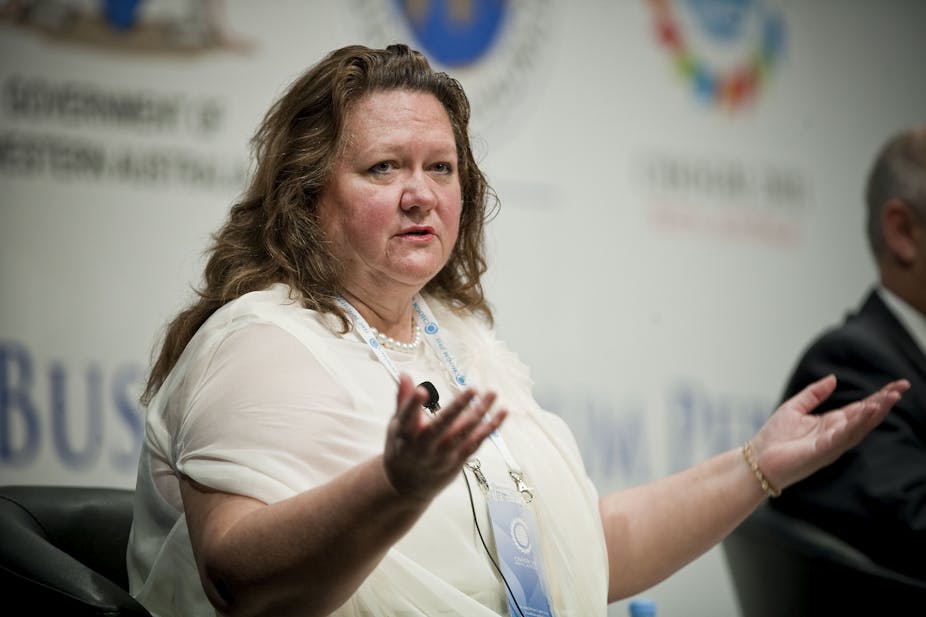Last weekend Channel 9’s two-part television drama, House of Hancock, was screened. It wasn’t quite the version that the producers had expected to air. After legal action was initiated against Channel 9 last Friday, cuts were made to the second episode and a disclaimer that “this program is a drama not a documentary” was added.
Gina Rinehart’s lawyers have indicated that they still intend to sue the network.
Rinehart claimed the program, described by Nine as “the controversial and epic true story of the Hancock dynasty”, was “replete with falsehoods, some knowing and deliberate, and is highly defamatory”. She was granted permission to watch episode two ahead of its broadcast on Sunday night, and several scenes were cut, with Rinehart arguing they might lead people to question her sanity and her love for her father.
Given the source material the producers had to draw on, including numerous books, court transcripts, and extensive media coverage of the events – why did they embellish it quite so much?
Sam Neill was cast as Lang Hangcock and, from the first close-up on his Hollywood-handsome face, it was clear that House of Hancock was a work of fiction. Lang, it was widely acknowledged, was as plain as a pikestaff. Putting Neill in thick, black-framed glasses and false teeth was never going to be enough to transform him convincingly into the craggy mining magnate.
Peta Sergeant was such a drop-dead gorgeous young Rose it was hard to suspend our disbelief when Lang seduced her – even if it was Sam Neill doing it and we know this actually happened.
Gina Rinehart, as played by Mandy McElhinney, was a more sympathetic character. In episode one at least she came across as a person more sinned against than sinning. But in the second part, Gina’s actions grow increasingly vengeful and erratic, if, at times, understandable.
The truncated part two was less compelling than part one – perhaps because of the cuts, the storytelling felt choppy and episodic. It is open to speculation whether Rinehart’s intervention compromised the artistic integrity of the episode. Whether the cuts saved her reputation is another matter: let’s be frank, Rinehart has never done herself any favours in garnering public sympathy.
It was always going to be risky for the producers to even tell this story, let alone make things up, as writer Katherine Thompson admitted doing to David Dale in the Sydney Morning Herald.
But even if you overlook the imagined scenes, such as Rinehart talking to her dead father, why alter what is on the public record? Tad Watroba, the executive director of Hancock Prospecting told Guardian Australia it was untrue that Gina continued honeymooning as her mother was dying, so why suggest she did? What narrative purpose does that serve other than to imply Rinehart was not a dutiful daughter?
This raises several complex questions. What responsibilities do scriptwriters have when writing about real people? What is their level of accountability when they dramatise real life, given there is an imperative to entertain?
Do they apply the same public interest tests, for example, that a journalist must when writing about people’s private lives?
One of the concerns for readers of literary journalism, where writers use literary techniques to tell stories about real people and events, is whether the use of such devices distorts the truth of the story, for example, re-creating dialogue from exchanges where the writer was not present.
With any form of journalism there is an expectation of accuracy – and recourse if that is breached. Should the writer of a fictionalised account of a living person accept the same responsibility ? Should writers at least exercise caution when tempted to alter the facts to suit their narrative arc?
Why shouldn’t writers of fiction adhere to an ethical framework when writing about living people as journalists do – or are expected to do?
Watroba also said Hancock did not tell Gina no-one could ever love her or that her husband never loved her. Who knows the truth about that apart from the two parties involved – but we do know that our relationships with the people we love are deeply private. Does a writer have the right to presume they can trespass on that sacred ground for the entertainment of the masses?
Rinehart’s lawyers have listed 20 “glaring errors” from episode two, several of which are encounters between Rose and Gina that Rinehart alleges never took place. Some of the disputed scenes remained in the broadcast, including one where Rinehart confronts her gravely ill father in hospital, which Rinehart’s lawyers claim is entirely untrue and false. It makes for good drama, but is it fair?
Producer Michael Cordell says the series was made without malice and with empathy. If the defamation case goes ahead it will be intriguing to see how it plays out.
John Rinehart has told The Australian that the series made him look like a Lurch from The Addams Family, always hanging around the house. But unlike his mother, he doesn’t intend to sue.

